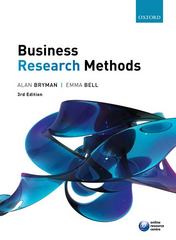Answered step by step
Verified Expert Solution
Question
1 Approved Answer
Jack Welch has been described by many as a transformational leader. With reference from the extract, argue for or against this assertion. SECTION A [
Jack Welch has been described by many as a transformational leader. With reference from the extract, argue for or against this assertion. SECTION A
MARKS
Read the extract below and answer the questions that follow.
The strategic leadership of GE CEO Jack Welch
The late former chairman and CEO of General Electric GE Jack Weich was heralded by many as the greatest leader of
his era. During his two decades at GE's helm, he transformed the organisation from a $ bilion USD maker of
appliances and lighibulbs into one of the most valuable companies in the world, while bulling a reputation for himself as
a manugement guru. What made Jack. Welch so successful? What were the sacrets and principles behind his appraach
to work and life? Jack Welch became GE's CEO in at the age of Upon taking office, he infialed a series of
changes to improve the performanoe of GE's diversfied business portfolio, with the hope of fundamentally reshaping the
companty over the next five years.
Despile resistance to change within the company, Welch was aware that past performance could not define future
success, and an organisation would not go arywhere without a sense of crisis. Transformation and innovation are keys
for survival. Three months afler taking over as CEO, Welch set a vision for each business unit that they had to be $ of
in their markets; if not, they had to fix, sell, or close the unit. This later became one of his most lamous strabegies.
Within the company, Welch sought to streamine GE with layolfs, eiminating the laborious strategic planning system,
ismantling the buresucrscy, and abolishing the ninelayer management hierarchy. As a result, GE's revenue expanded,
and opersing profits soared to $ bilion by In the labe s following GE's massive restructuring effort. Weich
proposed to develiop an approach to management characterized by speed, simplicity, and selfconfisence. To this end, he
launched WorkOut and Best Practices, two closely linked inifiatives that aimed at promoting aspired culsure and
management approaches. At Welch's request, GE promoted the WorkOut programme throughout the company. It
consisted of a group of to employees who were selected and inviled to a diseussion to share views about theif
own departrents and how they could be Afler WorkOut was implemented, Welch sought cut ideas that could raise GE's
productivily, and that led him to create Best Practices. This programme was desigred to develop effective processes by
studying and anstyzing the best practices of other highpefformance companies.
To align GE's established human resources system with the company's strategic targets, Welch also fadically overhauled
GE's compensation package by extending stock options to management compensation, and reengineering is bonus and
option allocation system in a more aggressive mamer to ensure was closely linked to the key strategies of the day. In
the s Welch crealed a new stralegic concept caled 'integraled diversity' and worked to make GE 'a boundaryless
company," which he described as "a company where we knock down the walls that separate us from each other on the
insibe and from our key consthuencies on the culside. The idea was aimed at encoursging employees to seek out and
share new ideas. To make this happen, he changed the way bonuses and options awards were delivered to honour
imovative and resourcesharing efforts. Moreover, Welch also introduced the notion of 'stretch' to set performance
targets to mothate higher levels of performance of managers, which he described as "using dreams to set business
targets, with no real idea of how to get there. In late s belore his retirement, Welch adopted Motorola's Six Sigma
qualify programme to improve the company's products and production procedures. In he announced that GE aimed
to attain its Six Sigma goals within five years. Although Weich had previously built up a lopnotched manogement team,
the closer he got to his planned retirement date, the more he wanted to enhance the GE's qualty for his successor.
Therelore, he modified his four types of managers to descrbe GE as a company that needed only 'A players' managers
who had vision, leadership, energy and courage. Whin only years, Jack Welch grew GE's market cap by over fold
to $ billion, making it the most valuable company in the world. During his tenure, he not only developed GE's
business with strategic vision, but also championed the company's international operations amidst increasing flobel
trade and culhural exchange.
Jack Welch was an outstanding, legendary leader and strategist who took a fresh bok at his work every day and made al
necessary and aggressive changes. In his two decades leading GE he fecorded an average of annual fotal

Step by Step Solution
There are 3 Steps involved in it
Step: 1

Get Instant Access to Expert-Tailored Solutions
See step-by-step solutions with expert insights and AI powered tools for academic success
Step: 2

Step: 3

Ace Your Homework with AI
Get the answers you need in no time with our AI-driven, step-by-step assistance
Get Started


